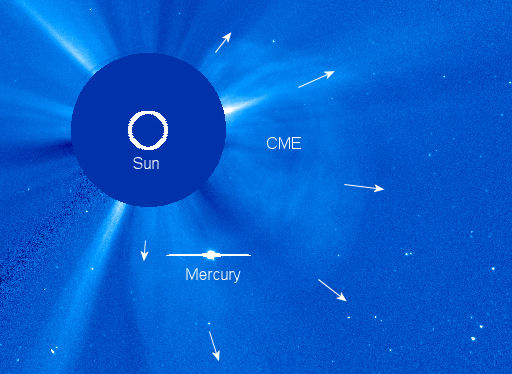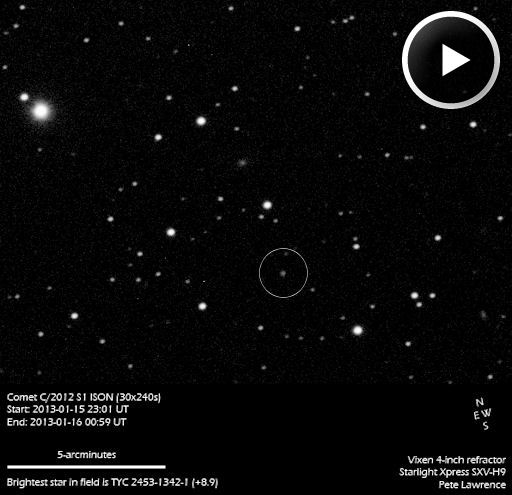CME IMPACT: A coronal mass ejection hit Earth's magnetic field on Jan. 19th at approximately 17:15 UT. The impact appears to be weak. Nevertheless, high-latitude sky watchers should be alert for auroras. Aurora alerts: text, voice.
The Solar and Heliospheric Observatory photographed the CME emerging from the sun's southeastern limb on Jan. 16th at 22:06 UT:
Although the cloud appears to be engulfing Mercury, it is not. Mercury is currently on the farside of the sun while the CME is on the nearside, heading more or less in our direction. The overlap is visual, not physical.
COMET OF THE CENTURY? Later this year, Comet ISON could become bright enough to see in broad daylight when it passes through the atmosphere of the sun. At the moment, however, it is a cold and lonely speck barely visible through backyard telescopes. On Jan. 16th, Pete Lawrence of Selsey, UK, photographed the potentially-great comet moving through space near the orbit of Jupiter:
Commentary from the Galactic Free Press~ If the above does not play for You go to this Link: http://spaceweather.com/ to View it. We found watching this Fascinating as you can clearly see something behind this comet, UHM what could it be? Love The Earth Allies
"I created the animation using images taken through a 4-inch refractor, starting at 23h on the 15th of January and ending at 01h on the 16th," says Lawrence. "The comet is clearly visible moving among the stars of Gemini, in an area just to the south of Castor."
Comet ISON looks so puny now because it is more than 600 million km away. In late 2013, however, it will be much closer. A key date is Nov. 28th when Comet ISON flies through the solar corona only 1.2 million km from the surface of the sun. If the comet survives the encounter--a big IF--it could emerge glowing as brightly as the Moon with a sensational tail sure to create a worldwide sensation. Stay tuned!

![]()
Solar wind
speed: 412.3 km/sec
density: 5.6 protons/cm3
explanation | more data
Updated: Today at 2027 UT
![]()
X-ray Solar Flares
6-hr max: B4 1711 UT Jan19
24-hr: C1 0351 UT Jan19
explanation | more data
Updated: Today at: 2000 UT
![]()
![]()
![]()
Daily Sun: 19 Jan 13
![]()
![]()
Decaying sunspot AR1654 no longer poses a threat for Earth-directed solar flares. Credit: SDO/HMI
![]()
![]()
![]()
Sunspot number: 56
What is the sunspot number?
Updated 19 Jan 2013
Spotless Days
Current Stretch: 0 days
2013 total: 0 days (0%)
2012 total: 0 days (0%)
2011 total: 2 days (<1%)
2010 total: 51 days (14%)
2009 total: 260 days (71%)
Since 2004: 821 days
Typical Solar Min: 486 days
Update 19 Jan 2013
The Radio Sun
10.7 cm flux: 115 sfu
explanation | more data
Updated 19 Jan 2013
![]()
![]()
![]()
Current Auroral Oval:
![]()
Switch to: Europe, USA, New Zealand, Antarctica
Credit: NOAA/POES
![]()
![]()
![]()
Planetary K-index
Now: Kp= 2 quiet
24-hr max: Kp= 3 quiet
explanation | more data
![]()
Interplanetary Mag. Field
Btotal: 4.0 nT
Bz: 3 nT south
explanation | more data
Updated: Today at 2026 UT
![]()
![]()
![]()
Coronal Holes: 19 Jan 13
![]()
![]()
There are no large coronal holes on the Earthside of the sun. Credit: SDO/AIA.






